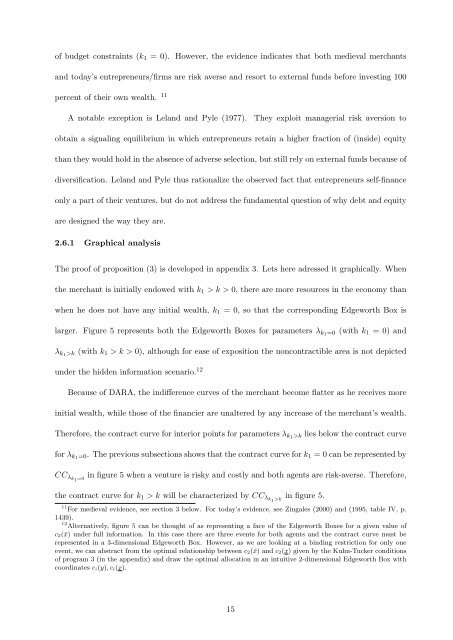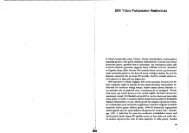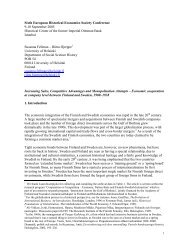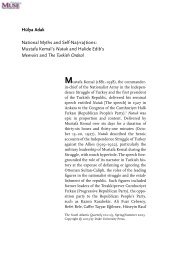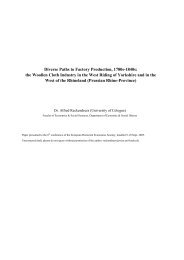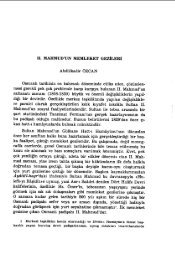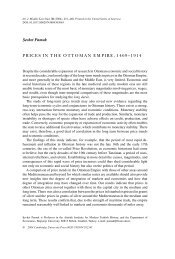The Birth of Insurance Contracts - The Ataturk Institute for Modern ...
The Birth of Insurance Contracts - The Ataturk Institute for Modern ...
The Birth of Insurance Contracts - The Ataturk Institute for Modern ...
You also want an ePaper? Increase the reach of your titles
YUMPU automatically turns print PDFs into web optimized ePapers that Google loves.
<strong>of</strong> budget constraints (k1 = 0). However, the evidence indicates that both medieval merchants<br />
and today’s entrepreneurs/firms are risk averse and resort to external funds be<strong>for</strong>e investing 100<br />
percent <strong>of</strong> their own wealth. 11<br />
A notable exception is Leland and Pyle (1977). <strong>The</strong>y exploit managerial risk aversion to<br />
obtain a signaling equilibrium in which entrepreneurs retain a higher fraction <strong>of</strong> (inside) equity<br />
than they would hold in the absence <strong>of</strong> adverse selection, but still rely on external funds because <strong>of</strong><br />
diversification. Leland and Pyle thus rationalize the observed fact that entrepreneurs self-finance<br />
only a part <strong>of</strong> their ventures, but do not address the fundamental question <strong>of</strong> why debt and equity<br />
are designed the way they are.<br />
2.6.1 Graphical analysis<br />
<strong>The</strong> pro<strong>of</strong> <strong>of</strong> proposition (3) is developed in appendix 3. Lets here adressed it graphically. When<br />
the merchant is initially endowed with k1 > k > 0, there are more resources in the economy than<br />
when he does not have any initial wealth, k1 = 0, so that the corresponding Edgeworth Box is<br />
larger. Figure 5 represents both the Edgeworth Boxes <strong>for</strong> parameters λk1=0 (with k1 = 0) and<br />
λk1>k (with k1 > k > 0), although <strong>for</strong> ease <strong>of</strong> exposition the noncontractible area is not depicted<br />
under the hidden in<strong>for</strong>mation scenario. 12<br />
Because <strong>of</strong> DARA, the indifference curves <strong>of</strong> the merchant become flatter as he receives more<br />
initial wealth, while those <strong>of</strong> the financier are unaltered by any increase <strong>of</strong> the merchant’s wealth.<br />
<strong>The</strong>re<strong>for</strong>e, the contract curve <strong>for</strong> interior points <strong>for</strong> parameters λk1>k lies below the contract curve<br />
<strong>for</strong> λk1=0. <strong>The</strong> previous subsections shows that the contract curve <strong>for</strong> k1 = 0 can be represented by<br />
CCλk 1 =0<br />
in figure 5 when a venture is risky and costly and both agents are risk-averse. <strong>The</strong>re<strong>for</strong>e,<br />
the contract curve <strong>for</strong> k1 > k will be characterized by CCλk 1 >k<br />
in figure 5.<br />
11<br />
For medieval evidence, see section 3 below. For today’s evidence, see Zingales (2000) and (1995, table IV, p.<br />
1439).<br />
12<br />
Alternatively, figure 5 can be thought <strong>of</strong> as representing a face <strong>of</strong> the Edgeworth Boxes <strong>for</strong> a given value <strong>of</strong><br />
c2(¯x) under full in<strong>for</strong>mation. In this case there are three events <strong>for</strong> both agents and the contract curve must be<br />
represented in a 3-dimensional Edgeworth Box. However, as we are looking at a binding restriction <strong>for</strong> only one<br />
event, we can abstract from the optimal relationship between c2(¯x) and c2(x) given by the Kuhn-Tucker conditions<br />
<strong>of</strong> program 3 (in the appendix) and draw the optimal allocation in an intuitive 2-dimensional Edgeworth Box with<br />
coordinates ci(y), ci(x).<br />
15


